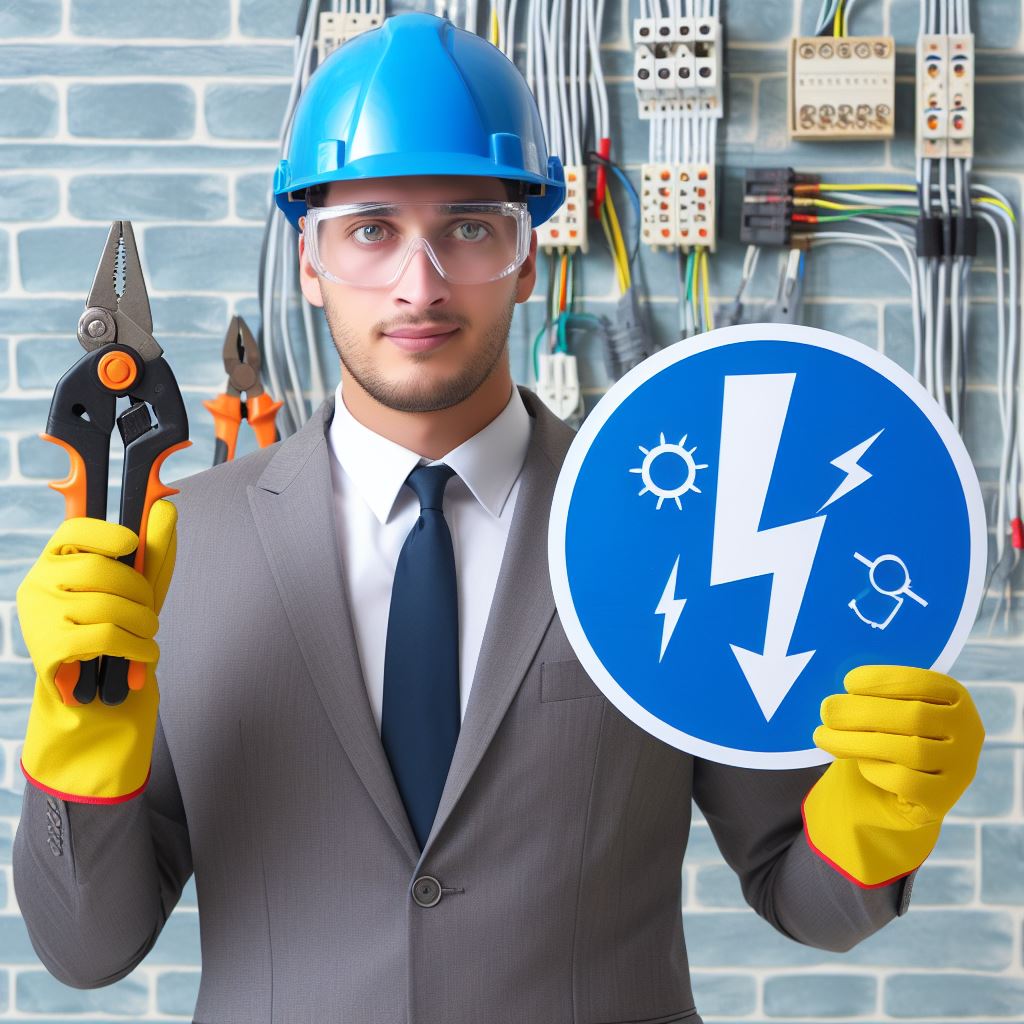Introduction
When working as an electrician, following safety tips is crucial to prevent accidents and injuries.
Implementing safety protocols ensures a secure working environment for both electricians and clients.
Importance of following safety protocols in the field
Electricians face various risks in their profession, making it essential to prioritize safety.
By following safety protocols, electricians can significantly reduce the likelihood of accidents.
These precautions are vital because they protect not only the electricians themselves but also the clients they serve.
Firstly, wearing appropriate personal protective equipment (PPE) is fundamental for electricians’ safety.
PPE includes safety glasses, gloves, helmets, and insulated boots.
Such equipment provides protection against electrical shocks, burns, and falling debris as they work on electrical systems.
Secondly, practicing proper electrical installation and maintenance procedures is crucial.
Electricians must ensure that circuits are de-energized and equipment is properly grounded to avoid electrical accidents.
They must also follow industry regulations and guidelines to ensure their work adheres to established safety standards strictly.
Furthermore, electricians should exercise caution when working with live wires.
They should always assume that wires are energized unless proven otherwise and take necessary precautions to avoid electrical shocks.
Using appropriate testing equipment and insulated tools reduces the risk of accidents.
Moreover, maintaining a clutter-free workspace is essential.
Personalized UK Career Consulting
Receive tailored career guidance designed just for you. Get actionable steps and expert support to boost your career in 1-3 days. Take control of your career now.
Get StartedElectricians should organize their tools and equipment properly to avoid tripping hazards.
Additionally, practicing good housekeeping helps prevent electrical fires and potential damage to electrical systems.
Overall, adhering to safety tips is critical for electricians.
By implementing safety protocols, they can minimize the risk of accidents, injuries, and electrical hazards.
Following safety guidelines ensures that both electricians and their clients can work and live in a secure environment.
General Safety Tips
Emphasize the significance of wearing appropriate personal protective equipment (PPE)
- Electricians must prioritize wearing PPE like safety goggles, gloves, and non-conductive footwear.
- Highlight the importance of protecting the eyes, hands, and feet from electrical hazards.
- Stress the need for properly fitting PPE to ensure maximum safety and effectiveness.
The importance of maintaining a clean and organized work area
- A clutter-free work area prevents tripping hazards and reduces the risk of accidents.
- Electricians should remove obstructions and keep tools and equipment in designated storage spaces.
- Regularly clean the work area to minimize the presence of dust, debris, and flammable materials.
Advising electricians to always work with a partner when possible
- Collaborating with a partner increases safety by providing assistance and providing a second set of eyes.
- Having a partner enhances communication and enables swift response to emergency situations.
- Working together also distributes the workload and reduces physical strain on individual electricians.
The significance of staying up-to-date with safety training and certifications
- Regular safety training ensures electricians are aware of the latest safety protocols and techniques.
- Maintain updated certifications to demonstrate competence and compliance with industry standards.
- Continuous learning and improvement contribute to a safer working environment and prevent accidents.
By following these general safety tips, electricians can significantly reduce the risk of accidents and injuries.
Read: UK Electrical Codes: What You Must Know
Electrical Hazards
Electrical hazards can pose significant risks to electricians on the job.
It is crucial for every electrician to be aware of these hazards and take appropriate safety measures to protect themselves.
In this blog section, we will discuss common electrical hazards, the dangers of electrical shock, the risks associated with arc flashes, and the hazards of working at heights.
Common Electrical Hazards
- Faulty Wiring: Improperly installed or damaged wiring can lead to electrical shocks and fires.
- Exposed Electrical Parts: Exposed wires and live electrical parts increase the risk of shocks and burns.
- Inadequate Grounding: Lack of proper grounding can cause electrical shock when equipment malfunctions.
- Overloaded Circuits: Overloading circuits can result in overheating and potential electrical fires.
- Wet Conditions: Working with electricity in wet or damp environments can cause electricians to get electrocuted.
Dangers of Electrical Shock and Importance of De-energizing Circuits
Electrical shock occurs when an electrician comes into contact with an electric current.
The severity of the shock depends on the voltage and current, but even low levels can be dangerous.
It is crucial for electricians to de-energize circuits before working on them to minimize the risk of electrical shock.
De-energizing involves turning off the power source and utilizing lockout/tagout procedures to ensure the circuit remains de-energized.
Your Dream Job Starts with a Perfect CV
Get a tailored CV and cover letter that captures your unique strengths and stands out in your industry. Let us help you make an unforgettable first impression.
Get StartedRisks Associated with Arc Flashes and the Need for Proper Protective Equipment
Arc flashes are explosive releases of energy caused by an electric arc.
They can result in severe burns, injuries, and even fatalities.
Electricians must have the appropriate personal protective equipment (PPE) to mitigate the risks of arc flashes.
This includes flame-resistant clothing, safety glasses, face shields, and insulated tools. Regular maintenance and inspections of electrical equipment can also minimize the chances of arc flashes occurring.
Potential Hazards of Working at Heights and the Need for Fall Protection Measures
Electricians often need to work at heights when installing or repairing electrical systems.
This introduces the risk of falls, which can lead to serious injuries or fatalities.
It is essential for electricians to use proper fall protection measures such as harnesses, lanyards, and guardrails when working at heights.
Inspecting ladders and scaffolding for stability and using them correctly can further enhance safety.
Therefore, electricians face various electrical hazards on the job.
By understanding and respecting these hazards, they can take the necessary precautions to ensure their safety.
This includes being aware of common electrical hazards, de-energizing circuits, using appropriate protective equipment for arc flashes, and implementing fall protection measures when working at heights.
Prioritizing safety is crucial for every electrician to have a long and successful career.
Read: Day in the Life of a UK Electrician

Safe Work Practices
Conduct a Thorough Risk Assessment
Before beginning any electrical job, it is crucial for electricians to conduct a thorough risk assessment.
Optimize Your LinkedIn for Success
Boost your LinkedIn profile with a professional bio, keyword-rich headline, and strategic recommendations that attract recruiters. Stand out from the crowd and get noticed.
Optimize NowThis helps identify potential hazards and develop appropriate safety measures.
Follow Proper Lockout/Tagout Procedures
When working on electrical systems, it is important to follow proper lockout/tagout procedures.
This ensures that energy sources are safely isolated, preventing accidental energization and protecting the electrician from electrical shock.
Properly Label Circuits and Electrical Panels
The significance of properly labeling circuits and electrical panels cannot be emphasized enough.
Clear and accurate labeling enables electricians to quickly identify the correct circuits and panels, enhancing overall safety and efficiency.
Verify De-Energization before Starting Work
Electricians should always verify that equipment is de-energized before starting any work.
This can be done using appropriate testing equipment and following established safety procedures.
It helps prevent electrical accidents and injuries.
Importance of a Thorough Risk Assessment
Conducting a thorough risk assessment is the foundation of electrical safety.
It involves carefully analyzing the work environment, equipment, and potential risks associated with the task at hand.
Here’s why it should never be overlooked:
- Identify Potential Hazards: Risk assessments help electricians identify potential electrical hazards, such as exposed wires, faulty equipment, or inadequate grounding. By recognizing these hazards, appropriate control measures can be implemented to mitigate risks.
- Develop Safety Measures: Through a risk assessment, electricians can develop effective safety measures tailored to the specific job. This may include wearing appropriate personal protective equipment (PPE), using proper tools, or implementing specific work procedures.
- Enhance Overall Safety: By thoroughly assessing risks before starting work, electricians can significantly reduce the chance of accidents and injuries. It promotes a safer work environment for both the electricians and other individuals present at the site.
- Comply with Regulations: Conducting a risk assessment ensures compliance with safety regulations and standards. This is especially important in industries where electrical work is prevalent, as non-compliance can lead to severe legal consequences.
The Significance of Lockout/Tagout Procedures
Working on electrical systems without proper lockout/tagout procedures can have serious consequences.
Understanding the importance of these procedures is crucial for every electrician.
Here’s why:
- Prevent Accidental Energization: Lockout/tagout procedures involve isolating electrical energy sources, such as switches or breakers, with locks and tags. This prevents accidental energization of equipment, protecting electricians from electric shocks and other potential hazards.
- Ensure Clear Communication: Lockout/tagout procedures use standardized tags and locks to communicate that equipment or circuits are not to be operated. This clear communication helps prevent misunderstandings and ensures everyone is aware of ongoing electrical work.
- Create a Safe Working Environment: Following proper lockout/tagout procedures creates a safer working environment for electricians. It establishes a consistent and reliable system that minimizes the risk of unexpected electrical activation during maintenance or repairs.
- Compliance with Safety Standards: Lockout/tagout procedures are mandated by safety standards and regulations. Adhering to these procedures not only protects electricians but also ensures compliance with legal requirements, preventing potential penalties and liabilities.
The Importance of Properly Labeling Circuits and Electrical Panels
Proper labeling of circuits and electrical panels is a critical aspect of electrical safety.
Here’s why electricians should always prioritize accurate labeling:
- Easy Identification: Well-labeled circuits and electrical panels allow electricians to quickly and easily identify the correct circuits when troubleshooting, maintaining, or upgrading electrical systems. This saves valuable time and effort, enhancing productivity and efficiency.
- Prevent Electrical Errors: Incorrectly identified or unlabeled circuits can lead to serious electrical errors. Electricians may accidentally work on energized circuits, risking electrical shocks, damage to equipment, or even electrical fires. Clear labeling minimizes these risks.
- Efficient Emergency Response: In emergency situations, such as power outages or electrical faults, properly labeled electrical panels enable swift identification and isolation of affected circuits. This facilitates faster troubleshooting and minimizes downtime.
- Safety for Both Electricians and Non-Electricians: Accurate circuit and panel labeling not only benefits electricians but also ensures the safety of non-electricians who may need to interact with electrical systems. Clear labels help prevent accidental contact with live circuits, reducing the overall risk of electrical accidents.
Always Verify De-Energization
Before commencing any electrical work, electricians must verify that equipment is de-energized.
Here’s why this step is crucial:
- Prevent Electrical Accidents: Verifying de-energization ensures that electricians are not exposed to live electrical current, minimizing the risk of electrical accidents, such as electrocution or arc flashes.
- Confirm Proper Isolation: By physically testing and measuring equipment, electricians can confirm that energy sources are isolated and effectively grounded. This prevents unexpected energization, protecting both the electrician and the integrity of the electrical system.
- Compliance with Safety Standards: Verifying de-energization is mandated by safety standards to ensure compliance. Electricians must follow established procedures, such as using appropriate testing equipment and personal protective gear, to meet these standards.
- Establish a Safety Culture: Making it a habit to always verify de-energization promotes a strong safety culture among electricians. It emphasizes the importance of personal safety and encourages others to prioritize safety measures in their work as well.
Basically, safe work practices are essential for every electrician.
By conducting thorough risk assessments, following proper lockout/tagout procedures, labeling circuits correctly, and verifying de-energization before starting work, electricians can ensure their own safety and the safety of others.
Prioritizing these practices establishes a culture of safety, reduces accidents, and promotes overall efficiency in electrical work.
Read: Electrician Licensing in the UK: A Primer
Tools and Equipment Safety
When it comes to electrical work, safety should always be the top priority for every electrician.
One of the crucial aspects of ensuring safety is the proper use and maintenance of tools and equipment.
Here are some important tips to follow for a safe and accident-free work environment.
Using Insulated Tools and Equipment
- Insulated tools and equipment are designed to provide protection against electric shocks.
- It is crucial for electricians to use only insulated tools when working with live circuits or electrical systems.
- Insulated gloves, pliers, screwdrivers, and other tools should be part of an electrician’s toolkit.
- These tools help prevent direct contact with live wires and minimize the risk of electrical accidents.
Regular Inspection and Maintenance
- Regular inspection and maintenance of tools are essential to ensure their proper functioning.
- Electricians should inspect tools before and after each use to identify any signs of damage or wear.
- Any damaged or worn-out tools should be immediately repaired or replaced to maintain safety.
- Regular maintenance ensures that tools are in good working condition and reduces the risk of equipment failure.
Using the Right Tool for the Job
- Using the right tool for a specific task is crucial for the safety and efficiency of electrical work.
- Electricians should familiarize themselves with the purpose and proper use of each tool in their arsenal.
- Using the wrong tool can lead to accidents, damage to equipment, or subpar work results.
- Always choose the appropriate tool for the job to ensure safe and effective completion of tasks.
Avoiding Damaged or Faulty Equipment
- Electricians must never use damaged or faulty equipment as it poses significant safety risks.
- Before using any equipment, inspect it for signs of wear, loose parts, or other defects.
- If any issues are found, it is crucial to report them immediately to the relevant authority or supervisor.
- Using damaged or faulty equipment can lead to accidents, injuries, and even electrical fires.
By following these safety tips and guidelines, electricians can greatly reduce the risk of accidents and ensure a safe working environment for themselves and those around them.
Remember, safety should never be compromised when it comes to working with electricity.
Read: The Future of Electricians in the UK
Emergency Preparedness
When it comes to working as an electrician, being prepared for emergencies is of utmost importance.
Electrical work can be dangerous, and it’s essential to have safety measures in place to protect yourself and others.
One crucial aspect of emergency preparedness is having a well-stocked first aid kit on-site.
The Need for a Well-Stocked First Aid Kit
Accidents can happen at any time, and having a first aid kit readily available can make a significant difference in minimizing the impact of injuries.
Your first aid kit should be well-organized and contain essential items such as bandages, antiseptic wipes, gloves, and pain relievers.
It’s crucial to regularly check and replenish your first aid kit to ensure it is always fully stocked.
In addition to having a first aid kit, it’s equally important to know the location of fire extinguishers and emergency exits in your workplace.
Electrical work involves handling live wires and working with potentially hazardous equipment.
In the event of a fire, being able to quickly locate an extinguisher can prevent it from spreading and causing further damage.
The Importance of Knowing Fire Extinguisher Locations
Fire extinguishers are designed to tackle specific types of fires, such as those caused by electrical equipment or combustible materials.
Each extinguisher is labeled with the types of fires it can be used on, so it’s crucial to familiarize yourself with their locations and understand how to operate them.
Having this knowledge can save lives and prevent the situation from escalating.
Moreover, being aware of the emergency exits in your workplace is essential for a swift and safe evacuation.
In the event of a fire or other emergencies, knowing where to go can make a significant difference in getting yourself and others to safety.
Take the time to familiarize yourself with the emergency exit routes and ensure they are always accessible and unobstructed.
The Significance of a Communication Plan
In a crisis situation, communication is key.
Having a communication plan in place ensures that everyone involved is informed and can respond appropriately.
As an electrician, it’s essential to have a system in place to communicate with your team or supervisor during emergencies.
This communication plan should include a designated meeting point where everyone can gather after evacuating the area.
It’s also crucial to have a list of emergency contact numbers readily available and to ensure that everyone on the team knows how to access and use it.
Regularly reviewing and updating this communication plan is vital to account for any changes or new team members.
In the electrical field, emergency preparedness is not an option – it’s a necessity.
By having a well-stocked first aid kit, knowing the location of fire extinguishers and emergency exits, and having a communication plan in place, electricians can enhance their safety and the safety of those around them.
Remember, being prepared can save lives and prevent accidents from turning into disasters.
Conclusion
The blog post outlined several essential safety tips that every electrician should follow.
These tips included wearing protective gear, inspecting equipment before use, and avoiding working in wet conditions.
By strictly adhering to these safety protocols, electricians can prevent accidents and injuries in the workplace.
It is crucial to emphasize the importance of following these safety protocols to protect oneself and others from harm.
Electricians should understand that accidents can have severe consequences, both on a personal and professional level.
By prioritizing safety, they can ensure a secure working environment and maintain their reputation as responsible professionals.
Furthermore, staying informed and updated on safety practices and regulations is equally essential.
As technology evolves, there are constant advancements and improvements in safety procedures.
Electricians must keep themselves educated about these changes to ensure they are implementing the most effective safety protocols.
Regular training sessions, attending seminars or workshops, and staying connected with professional networks are some effective ways to stay updated.
An electrician’s safety should never be compromised.
By consistently following safety tips, electricians can minimize the risk of accidents and injuries, allowing them to work efficiently and confidently.
It is the responsibility of every electrician to prioritize safety and take all necessary precautions to ensure a secure work environment.
Remember, safety should never be taken lightly, and staying informed is the key to maintaining high safety standards.
[E-Book for Sale]
500 Cutting-Edge Tech Startup Ideas for 2024 & 2025: Innovate, Create, Dominate
$19.99 • 500 Tech Startup Ideas • 62 pages
You will get inspired with 500 innovative tech startup ideas for 2024 and 2025, complete with concise descriptions to help you kickstart your entrepreneurial journey in AI, Blockchain, IoT, Fintech, and AR/VR.




